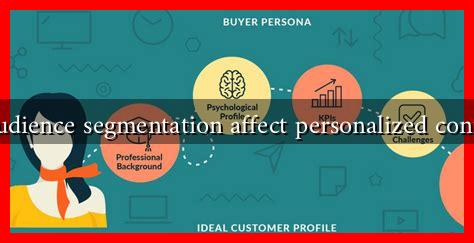-
Table of Contents
- How Does Audience Segmentation Affect Personalized Content Delivery?
- The Importance of Audience Segmentation
- How Segmentation Enhances Personalized Content Delivery
- 1. Improved Relevance
- 2. Increased Engagement
- 3. Enhanced Customer Loyalty
- Challenges of Audience Segmentation
- Best Practices for Effective Audience Segmentation
- Conclusion
How Does Audience Segmentation Affect Personalized Content Delivery?
In the digital age, the ability to deliver personalized content has become a cornerstone of effective marketing strategies. One of the most critical components of this personalization is audience segmentation. By dividing a broad audience into smaller, more defined groups based on specific characteristics, businesses can tailor their content to meet the unique needs and preferences of each segment. This article explores how audience segmentation impacts personalized content delivery, supported by relevant examples, case studies, and statistics.
The Importance of Audience Segmentation
Audience segmentation is the process of categorizing potential customers into distinct groups based on various criteria. These criteria can include demographics, psychographics, behavior, and geographic location. The primary goal of segmentation is to enhance the relevance of marketing efforts, thereby increasing engagement and conversion rates.
- Demographics: Age, gender, income, education level, etc.
- Psychographics: Interests, values, lifestyle choices, etc.
- Behavior: Purchase history, brand loyalty, online activity, etc.
- Geographic: Location, climate, urban vs. rural, etc.
How Segmentation Enhances Personalized Content Delivery
Personalized content delivery is significantly influenced by audience segmentation in several ways:
1. Improved Relevance
When content is tailored to specific audience segments, it becomes more relevant to the recipients. For instance, a clothing retailer might segment its audience into groups such as young adults, parents, and seniors. By understanding the unique preferences of each group, the retailer can create targeted marketing campaigns that resonate with each segment.
2. Increased Engagement
Personalized content tends to generate higher engagement rates. According to a study by Epsilon, 80% of consumers are more likely to make a purchase when brands offer personalized experiences. For example, Netflix uses audience segmentation to recommend shows and movies based on individual viewing habits, leading to increased user engagement and satisfaction.
3. Enhanced Customer Loyalty
When customers feel understood and valued, they are more likely to remain loyal to a brand. A case study by Forbes highlighted how Starbucks uses customer data to segment its audience and deliver personalized offers through its mobile app. This strategy has resulted in a significant increase in customer retention and loyalty.
Challenges of Audience Segmentation
While audience segmentation offers numerous benefits, it also presents challenges that marketers must navigate:
- Data Privacy Concerns: With increasing regulations around data privacy, marketers must ensure they are compliant while collecting and using customer data.
- Over-Segmentation: Creating too many segments can lead to confusion and dilute marketing efforts.
- Dynamic Audiences: Audience preferences can change over time, requiring continuous analysis and adjustment of segmentation strategies.
Best Practices for Effective Audience Segmentation
To maximize the benefits of audience segmentation, marketers should consider the following best practices:
- Utilize Data Analytics: Leverage data analytics tools to gather insights about customer behavior and preferences.
- Test and Optimize: Regularly test different segmentation strategies and optimize based on performance metrics.
- Focus on Customer Experience: Ensure that personalized content enhances the overall customer experience rather than overwhelming them with information.
Conclusion
Audience segmentation plays a pivotal role in the effectiveness of personalized content delivery. By understanding the unique characteristics and preferences of different audience segments, businesses can create more relevant, engaging, and personalized experiences that foster customer loyalty. While challenges exist, implementing best practices can help marketers navigate these hurdles and leverage the full potential of audience segmentation. As the digital landscape continues to evolve, the importance of personalized content delivery will only grow, making audience segmentation an essential strategy for success.

